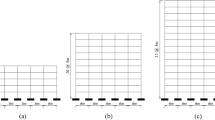Abstract
To verify the seismic design response factors of high-rise buildings, five reference structures, varying in height from 20- to 60-stories, were selected and designed according to modern design codes to represent a wide range of concrete wall structures. Verified fiber-based analytical models for inelastic simulation were developed, considering the geometric nonlinearity and material inelasticity of the structural members. The ground motion uncertainty was accounted for by employing 20 earthquake records representing two seismic scenarios, consistent with the latest understanding of the tectonic setting and seismicity of the selected reference region (UAE). A large number of Inelastic Pushover Analyses (IPAs) and Incremental Dynamic Collapse Analyses (IDCAs) were deployed for the reference structures to estimate the seismic design response factors. It is concluded that the factors adopted by the design code are adequately conservative. The results of this systematic assessment of seismic design response factors apply to a wide variety of contemporary concrete wall buildings with various characteristics.
Similar content being viewed by others
References
ACI (2005), Building Code Requirements for Structural Concrete and Commentary (318-05), American Concrete Institute, Detroit, Michigan.
Aldama-Bustos G, Bommer JJ, Fenton CH and Stafford PJ (2009), “Probabilistic Seismic Hazard Analysis for Rock Sites in the Cities of Abu Dhabi, Dubai and Ra’s Al Khaymah, United Arab Emirates,” Georisk: Assessment and Management of Risk for Engineered Systems and Geohazards, 3(1): 1–29.
Ambraseys NN, Douglas J, Sigbjornsson R, Berge-Thierry C, Suhadolc P, Costa G and Smit PM (2004), Dissemination of European Strong-motion Data, Vol. 2, Using Strong-motion Datascape Navigator, CD ROM Collection, Engineering and Physical Sciences Research Council, Swindon, UK, Feb. 2004.
ASCE (2006a), Minimum Design Loads for Buildings and Other Structures, ASCE Standard ASCE/SEI 7-05 Including Supplement No. 1, American Society of Civil Engineers, Reston, VA.
ASCE (2006b), Seismic Rehabilitation of Existing Buildings, ASCE Standard ASCE/SEI 41-06 “formerly FEMA 356, American Society of Civil Engineers, Reston VA.
Borzi B and Elnashai AS (2000), “Refined Force Reduction Factors for Seismic Design,” Engineering Structures, 22(10): 1244–1260.
CSI (2008), ETABS — Integrated Building Design Software, Computers and Structures, Inc., Berkeley, California.
Elnashai AS, Papanikolaou V and Lee D (2010), Zeus- NL — A System for Inelastic Analysis of Structures — User Manual, Mid-America Earthquake Center, Univ. of Illinois at Urbana-Champaign, Urbana, IL.
FEMA (2009a), NEHRP Recommended Seismic Provisions for New Buildings and Other Structures, FEMA P-750 2009 Edition, Part 1: Provisions and Part 2: Commentary to ASCE/SEI 7-05, Federal Emergency Management Agency, Washington, D.C.
FEMA (2009b), Quantification of Building Seismic Performance Factors, FEMA P695, Federal Emergency Management Agency, Washington, D.C.
Ghobarah A (2004), “On Drift Limits Associated with Different Damage Levels,” Bled’04 International Workshop on Performance-Based Seismic Design, June 28–July 1, Bled, Slovenia.
Huang K, and Kuang JS (2010), “On the Applicability of Pushover Analysis for Seismic Evaluation of Medium and High rise Buildings,” The Structural Design of Tall and Special Buildings, 19(5): 573–588.
ICBO (1997), Uniform Building Code, 1997 Edition, International Conference of Building Officials, Whittier, California.
ICC (2009), International Building Code, International Code Council, Country Club Hills, IL.
Mwafy AM (2009), Seismic Design Response Factors and Vulnerability Functions of Typical UAE Buildings, Phase I: Response factors, UAE University, Al Ain, UAE.
Mwafy AM and Elnashai AS (2001), “Static Pushoverversus Dynamic Collapse Analysis of RC Buildings,” Engineering Structures, 23(5): 407–424.
Mwafy AM and Elnashai AS (2002), “Calibration of Force Reduction Factors of RC Buildings,” Journal of earthquake engineering, 6(2): 239–273.
Mwafy AM, Elnashai AM, Sigbjornsson R and Salama A (2006), “Significance of Severe Distant and Moderate Close Earthquakes on Design and Behavior of Tall Buildings,” Structural Design of Tall and Special Buildings, 15(4): 391–416.
Mwafy AM, Elnashai AM and Yen WH (2007), “Implications of Design Assumptions on Capacity Estimates and Demand Predictions of Multispan Curved Bridges,” ASCE Journal of Bridge Engineering, 12(6): 710–726.
PEER (2009), PEER NGA Database, Pacific Earthquake Engineering Research Center, University of California, Berkeley, California.
Priestley MJN and Grant DN (2005), “Viscous Damping in Seismic Design and Analysis,” Journal of Earthquake Engineering, 9(2): 229–255.
SEAOC (1999), Recommended Lateral Force Requirements and Commentary, 7th ed, Seismology Committee Structural Engineers Association of California, Sacramento, CA.
Tso WK, Zhu TJ and Heidebrecht AC (1992), “Engineering Implications of Ground Motion A/V Ratio,” Soil Dynamics and Earthquake Engineering, 11(3): 133–144.
Ventura CE and Ding Y (2000), “Linear and Nonlinear Seismic Response of a 52-storey Steel Frame Building,” The Structural Design of Tall Buildings, 9(1): 25–45.
Willford M, Whittaker A and Klemencic R (2008), Recommendations for the Seismic Design of High-rise Buildings, Council on Tall Buildings and Urban Habitat, Chicago, IL.
Author information
Authors and Affiliations
Corresponding author
Additional information
Supported by: UAE University Under Contracts No. 07-34-07-11/07 and 07-01-07-11/09
Rights and permissions
About this article
Cite this article
Mwafy, A. Assessment of seismic design response factors of concrete wall buildings. Earthq. Eng. Eng. Vib. 10, 115–127 (2011). https://doi.org/10.1007/s11803-011-0051-7
Received:
Accepted:
Published:
Issue Date:
DOI: https://doi.org/10.1007/s11803-011-0051-7




